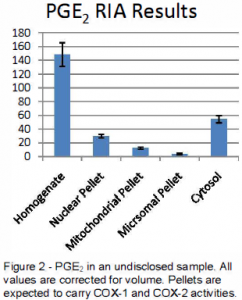Jacob Orme and Dr. Daniel Simmons, Department of Chemistry and Biochemistry
Most of the results of my work are confidential pending publication. This also applies to the public availability of my honors thesis, which will not be printed until later this year as a result. This fact highlights two important points: 1) I will be unable to offer many specifics in this report-although I will offer as much information as possible1-and 2) more importantly, this ORCA project has been extraordinarily successful.
Cyclooxygenase enzymes produce prostaglandins, which in tum play major roles in inflammation, pain, and the immune response (see Figure 1). Cyclooxygenases catalyze oxygenation and peroxidase activities in the cascade. Drugs inhibiting these enzymes (termed non-steroidal anti-inflammatory drugs or NSAIDs) have been an important source of pain and inflammation relief. Beyond inflammatory responses, prostaglandins play important roles in processes like cancer development, smooth muscle tension, hormonal regulation, and platelet formation. Unfortunately, interruption of this integrated system can lead to unfortunate sideeffects like peptic ulcers and heart problems. Given these nuances, a better understanding of cyclooxygenases, their products, and their inhibitors is important to ensure safe and effective clinical applications.

As mentioned in my honors proposal, a new cyclooxygenase activity has been observed in our laboratory (see Figure 2). This activity is strange because of its location, its lack of regular and conserved cyclooxygenase epitopes, and its responses to environmental cues that differ drastically from classical cyclooxygenases.

My project has been the further characterization of this activity. This included the isolation of its genetic source using gene knockout technology and BLAST searches, the determination of an appropriate physical source for its purification, the completion of drug inhibition profiles that establish its active site reactivity, the evaluation of its size and other pertinent characteristics, and the development of methods for its purification.
These results have been verified both empirically in the laboratory and computationally using AutoDock® on the campus supercomputer MaryLou4. This was a new avenue of research in our laboratory but produced extremely useful results. Their publication is pending and they have opened further avenues of research as new questions have arisen in the study of this activity.
